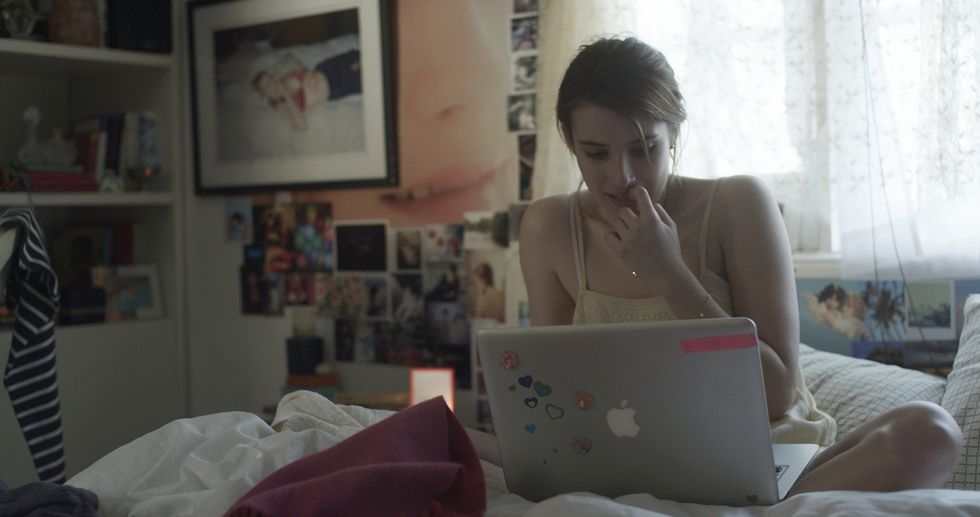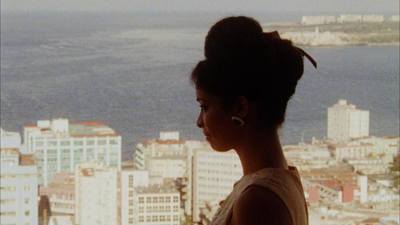
BY KAREN KEMMERLE |
Gia Coppola Talks ‘Palo Alto’ And James Franco’s Take On The Female Perspective
We talk to Gia Coppola about her directorial debut, the role of fantasy in the lives of teens, and making ‘Palo Alto’ a video and audio experience.

Keep your eye on Gia Coppola, the most recent and youngest Coppola to enter the family business. She makes her feature length directorial debut with Palo Alto, which she adapted from James Franco’s acclaimed book of short stories, Palo Alto: Stories. Easily one of the hottest commodities at the 2014 Tribeca Film Festival, Coppola’s first film is remarkably self-assured, filled with striking imagery, a pitch-perfect soundtrack, and skillful performances from Emma Roberts, Nat Wolff, newcomer Jack Kilmer and even Franco himself.
We talk to Coppola about her screenwriting process, directing actors for the first time, and learning about filmmaking in the edit room.
Tribeca: I understand that James Franco sent you a copy of Palo Alto: Stories after being introduced to you at a party by your mother. Can you talk about your initial meeting?
Gia Coppola: That’s the short version. When we met, he proposed a lot of different ideas about how we could collaborate in some form or another. He mentioned Palo Alto Stories and that sounded like the most interesting project to me. Shortly after, I read the book and loved it. So that’s the project we decided to pursue together.
Tribeca: Obviously, you could have picked a number of characters and stories from James Franco’s book, but you chose to mainly incorporate “Jack-O’,” “Emily” and the three-part story “April” into your film. Why did you choose these three stories?
GC: The “April” story really stood out to me. I loved the longing of the two characters; they are people who can’t really express their feelings. Plus, it was a bit of a longer story so there was more for me to work with. I also loved the dialogue in the "Jack-O" story. I thought it would be a good way to frame the whole piece with a beginning and end. While those were the three main stories I took from, I did take elements from the other stories. Unlike a novel, I had to take bits and pieces from all of Palo Alto: Stories to make it fit for the screen.
One of the features of James’s book that really struck me was how capable he was of conveying the young female perspective—so often he was dead on.
Tribeca: One thing that really struck me about the book was James Franco’s ability to write from the female perspective. How important is it for female stories to be told? Why does it seem they are mostly being told by independent filmmakers at this time?
GC: That’s a good question. I do feel like filmmakers are beginning to focus on making female characters more interesting and complex, especially in the indie film world. It’s refreshing. Blockbusters tend to have a set character format. I don’t think even male characters are complex. They are just mostly action figures, you know? One of the features of James’s book that really struck me was how capable he was of conveying the young female perspective—so often he was dead on. [laughs]I had to wonder how this 35-year-old man is able to empathize so well?
Tribeca: As a first time screenwriter, did the screenwriting process seem daunting? What was the most difficult part of the process?
GC: It did seem daunting at first, but James really helped me step by step. I wrote each story in a script format, and then we made a test film of one of the scripts. I was really naïve about the whole process, but that turned out to be to my advantage. I wasn’t really daunted by all of the things that could have deterred me as I might have been if I was a little more aware of the process. After I wrote each story in screenplay format, it was much easier for me to see how I could combine characters and intertwine them into one cohesive story. I didn’t want a series of vignettes.
Tribeca: There are moments when the characters in the film start to role-play (Emma Roberts in her bedroom; Nat Wolff playing the song at the party). How important is fantasy in the life of a teen? Is having fantasies an essential part of growing up?
GC: In my life, it for sure was. I remember spending a lot of time in my room listening to music or playing dress up or on the computer. I always enjoyed daydreaming – and I think that tendency added a bit more complexity to Emma’s character. You see her being fine in her room by herself, so you know that when she’s around other people, you can trust seeing things through her eyes.

Tribeca: Speaking of Emma and Nat, even though they have been in the public eye for quite sometime, their roles in Palo Alto are positively transformative. Can you talk about casting them? What qualities made them so right for the roles of Fred and April?
GC: I was really nervous about finding a young actor capable of playing the role of Fred. The character is so intense that it was really hard to cast. Nat Wolff was suggested to me so I looked him up, and I was struck by how relatable he looked. We met and just hit it off. He really understood the script and had a number of ideas about similar characters he could draw from. He didn’t even need to audition; I just trusted him. He normally plays these meek roles so he was anxious for the chance to try something wilder.
Tribeca: You can’t help but think of Johnny Boy in Mean Streets when you watch his performance.
GC: Yeah, that was one of the characters he and I talked about.
Tribeca: And what about Emma?
GC: Emma and I have a similar background so I knew her just from living in and out of Los Angeles. I had seen her in Celeste & Jesse Forever and thought she was so, so good. She’s always been very supportive of me and, for some reason; she kept coming into my head for April. I kept running into her too, so I felt like the universe was forcing us together. As a first-time director, I was nervous, so I wanted someone with experience. Plus, she was just so generous with Jack Kilmer, who had never really acted before.
Emma is a little bit older so she was able to have that outside perspective when she was getting back into the mindset of a teen. I feel like teenage girls act mature when they’re really not, and Emma was able to convey that conflict
Tribeca: You mentioned Jack Kilmer, who feels like the discovery of the film. Did you always have him in mind for Teddy?
GC: I’ve known Jack since he was little. We went to the same elementary school, and my grade mentored his grade. I remember him being really young. I worked on Twixt with his dad Val, and Jack would come visit. I never really considered him for the part until I was auditioning all these kids. I went out to dinner with him and I was just so much more enamored with him than with the professional teen actors. Jack is a real teenager and has that natural quality that just makes you want to watch him because he looks at the world so uniquely.
Tribeca: As a first time director, how did you approach working with actors? Did you encourage them to improvise?
GC: I was nervous about working with actors. I felt comfortable with all the other elements of making a movie because I had been on film sets before. I’m a shy person, so interacting with people makes me anxious. We did a week of rehearsals, but we didn’t focus on the scenes too much. We just kind of got to know each other and played games. Jack and Nat lived at my mom’s house during filming, so they developed a real friendship that came through in the movie.
I just tried to be very honest and as giving as possible with the actors. Plus, I was very open to their ideas—they are young and could let me know if the language I was using was outdated. They kept me hip with the times. [laughs]

Tribeca: James Franco is also a director along with all of the other different hats he wears. You’re directing the man who is also a director who wrote the book that the film is based on—can you talk a little bit about that experience?
GC: It was a great experience for me because I had someone there to tell me about the background behind his characters. Since he’s a director and a teacher too, he was very helpful with blocking some tricky scenes. Whenever I had questions about the dialogue or felt stuck, he was there. It was a really good learning experience for me to work with someone who’s that talented and such a pro.
Tribeca: You initially went to school to be a photographer, then starting doing short fashion films post-graduation. Can you talk about working with your DP Autumn Durald? Did you look at particular movies or artwork as reference points?
GC: Autumn and I had worked on some short films that I did for fashion companies. It was really important for me to not make this experience intimidating. So I just worked with everyone I worked with on these smaller projects. We’re all under 30, and it was exciting for us to have our first chance at a feature film together. Autumn and I just kind of have this very natural relationship—we can communicate with each other without words. We were really on the same page as far as movie references and film photographs. Plus, we both don’t really like the shaky camera thing that’s going on right now. [laughs]
After I wrote each story in screenplay format, it was much easier for me to see how I could combine characters and intertwine them into one cohesive story.
Tribeca: Palo Alto is both a visual and audio experience. I love Rooney, so I was really pleased that your cousin Robert had a hand in the score, along with Devonte Hynes. What notes did you give them as they composed the music for the film?
GC: I really wanted to convey the emotions that these kids all feel through music. I didn’t want to go the easy route of some hip soundtrack full of modern music or current pop hits. I want to look back at this film and not ever feel like it is dated. I wanted something just a little more timeless, and Devonte and Robert agreed. I let them take it away because I’m a fan and I trusted what they felt was right.
Tribeca: You mentioned how you wanted the film to feel timeless. I noticed that except for one or two moments in the film, there wasn’t a lot of smartphone usage. These kids weren’t constantly glued to them. Was that a conscious decision?
GC: That was something I was trying to figure out. I felt like if I included smartphones, the film would become a whole other story about teenagers that I didn’t want to explore. Plus, James’ book takes place in the 90’s. I think he did that on purpose so he didn’t have to involve that whole element of what goes on in teenage lives today.
It was a tricky decision on how to make something modern and not include cell phones. So I just tried to use them sparingly. Interestingly, with Jack I found it impossible to get in touch with him while making the movie because he never picked up his phone. I had to chase him down when I wanted him for the part.
Tribeca: Given your family, do you feel that making a film is a rite of passage in a strange way? Do you think you will continue to make movies?
GC: Filmmaking has been around me my whole life, so it felt natural to go in that direction. I studied photography at school, and then I started making short films with my friends. Telling stories through various media has always been something that I naturally enjoyed. Plus, I’ve also liked the atmosphere of a set. I hope to make movies forever.
Palo Alto opens this Friday, May 9, in NY and LA. Click for more info.

